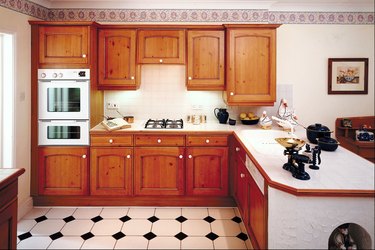 Install drywall first for the best finish. Image Credit: Jupiterimages/Photos.com/Getty Images
Install drywall first for the best finish. Image Credit: Jupiterimages/Photos.com/Getty Images
Kitchens feature a combination of construction elements and fixtures, and it can be confusing when you're trying to figure out the best configuration for these elements. Drywall, which provides a smooth, flush wall throughout the house, is also beneficial when installed behind the stove and cabinets. While it's possible to cut and install drywall later, to fit around the cabinets after they're in place, you won't get the same professional results.
Video of the Day
Unfinished Walls
Unfinished kitchen walls contain wiring and plumbing, and if the walls are exterior walls, they will contain insulation. Drywall acts as a sealer, separating the mechanical elements in the stud spaces from the rest of the kitchen. Before hanging the drywall, you'll need to know where the cabinets will go and install backers between the studs to hold the heavy cabinets.
Drywall Cost
As far as construction materials go, drywall is one of the least expensive. As of November 2011, a 4-foot by 8-foot sheet of 1/2-inch thick drywall sells for about $7 a sheet and a full sheet covers 32 square feet of wall space. Even though the drywall behind the cabinets and stove will not be visible, installing the panels will not substantially add to the cost of the kitchen.
Labor
If you wait to install the drywall until after the cabinets are in place, you'll spend a lot more time than if you install the drywall first. Once the cabinets are set, you'll have to measure and fit each piece of drywall around the sides and the tops of the cabinets. In addition, once the cabinets are on, the drywall will butt into the sides of the cabinets, which will create an unprofessional look.
The Cabinets
There is a two-step process to installing cabinets. Before you hang the drywall, locate where the cabinets will go and install backers between the studs at these locations. Backers are 2-by-4s, installed flat between the studs and flush with the surface of the studs. This will leave some room behind the backers for wiring and it will provide a frame sturdy enough to hold the cabinets. After you hang the drywall, you can use a stud finder to locate the position of the studs and backers.


